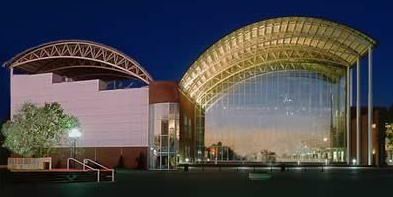If you are stationed in Hampton Roads, I highly recommend you visit The Virginia Air & Space Center in Hampton, Virginia. The VASC is also the visitor center for NASA Langley Research Center and Langley Air Force Base, VASC features hands-on aviation & space exhibits spanning 100 years of flight, more than 30 historic aircraft, space flight artifacts and a giant-screen 3D IMAX Theater.

What's new at The VASC?
Virginia Air & Space Center Opens Two New Permanent Exhibits, Robots 3D and the Robotics Lab!
The Virginia Air & Space Center is pleased to announce the opening of the new permanent exhibit, Engineer It, opening July 1, 2015. Engineer it! an Imagination Playground is a new and innovative playground that allows families to have fun creating and learning together. This new playground equipment system encourages learning, social development, movement, and above all, FUN! VASC’s new exhibit for young children helps to inspire young builders in STEM (science, technology, engineering and math) while allowing them to be creative and imaginative. The exhibit also features larger-than-life blocks for giant scale buildings and table top blocks for smaller hands. Kids of all ages will be able to experience a whole new world- engineering new structures using the curved blocks, attachments and more! From animals to robots, houses to rocket ships, kids are encouraged to think outside the box, while working together. You can take Engineer-it! an Imagination Playground home with the Imagination Playground 3D Builder app, available on both Apple and Android Devices.
AND
The Virginia Air & Space Center is pleased to announce the opening of the new permanent exhibit, Solarium, opening July 1, 2015. The Solarium at VASC: Reaching New Heights will immerse students, teachers, preservice teachers, and life-long learners into the Sun’s atmosphere and give them an up-close and personal look into the world of heliophysics (the study of the sun and its interactions with Earth) and helioseismology (the study of the propagation of wave oscillations in the Sun). Journey into the Sun’s atmosphere and explore the unique features of the Sun, creating an out-of-this-world experience. Be mesmerized by the Sun’s dancing atmosphere while you are standing next to, and listening to, the sounds of the Sun! The images used by Solarium were taken and recorded by NASA’s Solar Dynamics Observatory (SDO), which can take a picture almost once per second. The SDO is able to capture these wavelengths of light, varying from ultraviolet (invisible to the naked eye) to visible light. Once the SDO captures these images, it sends data in the form of binary (0’s and 1’s) back to scientists who then translates the data into the images seen at the Solarium. The images that are produced have the resolution of eight times that of an HD TV and are turned into a time lapse video. VASC will work with Solarium’s creator, Genna Duberstein, an award-winning multimedia producer at NASA GSFC, to design and implement the very first full Solarium display. This exhibit will cover more than three walls of a designated area at the Center and will use the classic ambient sounds of the sun produced by real sun data.
Robots 3D, an IMAX film, takes audiences on a lively tour around the world to meet the most remarkable robots in Europe, Japan and the United States. RoboThespian, narrated by actor, comedian and filmmaker Simon Pegg, gives you rare access to labs, where researchers are striving to replicate human capabilities. Robots 3D explores the latest in the field of artificial intelligence and machine learning, humanoid cognition and human-robot interaction (HRI), as well as exciting developments in cloud robotics. Robots 3D gives audiences a fascinating and exciting look at what makes us human, how far machines must really go to look and act like us, and how humanoids are already changing our world. The Robotics Lab at VASC is a new state-of-the-art laboratory that will offer students and teachers with opportunities to engage themselves with hands-on robotics technology. Through this new application, children will be encouraged to become creative thinkers and lifelong learners. Students will participate in competitions with missions related to NASA’s current projects, and explore the world of 3D printing and how it supports the International Space Station and future missions. Robotics is used to enhance the science and math curriculum and also promotes problem solving, critical thinking, imagination, creativity and team building.
Virginia Air & Space Center is proud to support the military community and has just increased their military discount offer. You can learn more about The VASC, other exhibits, location, and their military discount on MilitaryBridge.
